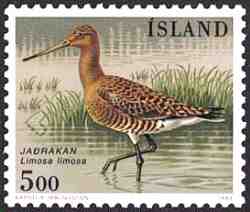The Black-tailed Godwit Limosa limosa used to flourish in the peat soil habitats in the western part of the Netherlands. Invertebrates profited from enrichment of the soil with manure and fertilisers and earthworms (Lumbricidae), leatherjackets (Tipulidae), snails and other species were abundant. The combination of abundant food, at least for adult birds, and the soft peat soil (which is easily penetrated by the long bill of the Black-tailed Godwit) made the western part of the Netherlands a prime breeding habitat for the Black-tailed Godwit. Nearly 80% of the western Europe population of the Black-tailed Godwit, currently estimated at 80,000 pairs and by far the largest in Europe, breed in the Netherlands. However, the key Dutch breeding population underwent a large decline from 120,000-135,000 in 1969, 85,000-100,000 in 1989-1991 to 62,000 in 2004. Over the last 15-20 years, the important breeding populations in Germany, Poland and Belarus have been reduced by 50% as well. Evidence collected in the Wormer- and Jisperveld reserve in the western province of North-Holland (a 2200 ha soft peat wetland reserve with high water tables and restrictions in agricultural management) suggests that the decline of the Black-tailed Godwit may be caused by a lack of larger insects on which the chicks depend for their survival.
The decline of the number of breeding pairs of the Black-tailed Godwit in the Wormer- and Jisperveld reserve was 1% per annum from 2001 to 2004, 5% per annum from 2004 to 2006, and 22% in 2007 . Insect sampling in early May 2007 (Black-tailed Godwit hatching) and the middle of May 2007 (when chicks need large quantities of large insects) showed that larger insects (> 4 mm) were in short supply in the middle of May. This is consistent with evidence indicating that large carabid beetles (> 8 mm) associated with open, marshy or grassland habitats (including many agricultural habitats) have suffered the largest declines over the last 50 years. This is probably due to changes in agricultural practices including intensification of the use of pesticides. In the Dutch breeding population of the Black-tailed Godwit, chick survival has decreased from 17-42% in the 1980s to 0-24% in 2003-2005, and reproductive success has declined rapidly from c. 0.7 chicks per pair per year in the 1980s to 0.1-0.4 chicks per pair per year in 2003-2005. This is far below the threshold for a sustainable population.
Sources:
Groen NM & Hemerik L (2002). Ardea 90 (2): 239-248
European Commission (2007). Management Plan for Black-tailed Godwit 2007-2009. Technical Report-019-2007, Luxembourg Office for Official Publications of the EC
Snow DW & Perrins CM (1998). The Birds of the Western Paleartic, Concise Edition ed., Volume 1 +2, Oxford University Press, Oxford
Teunissen WA et al. (2005) Toelichting op de gruttokaart van Nederland 2004. SOVON Onderzoeksrapport 2005/4. SOVON Vogelonderzoek Nederland, Beek-Ubbergen
Thorup O (2005) Waders Breeding in Europe 2000 – International Wader Studies 14, IWSA-UK
Vens N (2008). Broedvogelinventarisatie Wormer- en Jisperveld 2007. Vogelbeschermingswacht “Zaanstreek”.
Verhulst J et al. (2008). Voedselaanbod voor gruttokuikens in de Hollandse veenweidegebieden. Wageningen, Alterra, Alterra-rapport 1668, ISSN 1566-7197.
Kotze DJ & O`Hara RB (2003) Species decline - but why? Explanations of carabid beetle (Coleoptera, Carabidae) declines in Europe. Oecologia 135:138-148
Jensen FP et al. (2008). International Single Species Action Plan for the Conservation of the Black-tailed Godwit Limosa limosa, AEWA Technical Series No.XX. Bonn, Germany

- Log in to post comments
